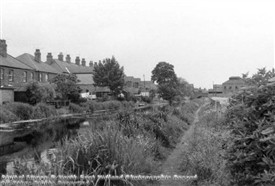Retford - Spa Town

Spa Common, Retford, alongside the Chesterfield Canal in 1968
When local spring water was prized for its healing properties
By Rewind Retford
It may have been described as "red and unpleasant, with a white scum on top", but in days gone by, water bubbling up from a spring on Retford's Spa Common was valued for its curative properties.
Two Commons
In ancient times Retford had two commons, Spa Common and Far Common.
The latter is now largely covered by the former Grammar School and its grounds.
Spa Common, and Spa Lane which lead up to it, took their name from a natural spring which rose in the north east corner of the common. The water which issued forth, it was believed, had curative qualities when used either internally or externally.
It was said to be excellent for the treatment of weak or sore eyes, and as a purgative or emetic. There were those, too, who swore by it as an effective treatment for rheumatism.
Taking the Waters at Retford
In the book The Mineral Spas of England, published by J.C. Short MD in 1734 it is recorded that the water bubbled to the surface inside a handsome freestone basin which itself was enclosed in a pleasant, decorated building shaped like a pyramid.
"...Red and Unpleasant with a White Scum on top..."
In the early 19th century, there are references to it being enclosed in a three-sided stone building, open at the front, and containing a metal cup chained to the wall.
By 1815 the condition of the well - and more particularly its misuse (so it was said) by cattlemen - had become nothing less than a local scandal.
The Commons masters - John Kirke and John Hutchinson - decided to pull down the building, fill in the well, and pipe its waters to one of the open drains of the town.
So strong was Retfordians' belief in its curative powers, however, that many people continued to fetch water from the outlet, causing, in 1837, Robert Hudson (a brick and tile maker and son of a former bailiff) to be commissioned to install pipes and drain the Common into the Beck.
There was a storm of protest, and eventually, bowing to public opinion, Hudson ended up clearing and re-opening the well at his own expense. He repaired its brick walls and placed a pump over the well with a drain to carry away surplus water.
With these improvements the well enjoyed a resurgence in popularity, and, by 1857, according the Retford's principal historian, John Piercy**, it was working overtime.
But What did the Water Taste Like? And was it Any Good for You
Piercy drank the water himself and described it as of a red colour and unpleasant in taste - tasting, he said, like ink.
(Piercy, it should be remembered, was a schoolmaster at the National School on Chapelgate, so may have been familiar with the taste of ink as it was made up in school from gall nuts which have a very bitter taste).
J.C Short's The Mineral Spas of England, (1734) stated that the water took its red colour from iron oxide, and, when left standing, it developed a white scum on top - not doubt from the presence of gypsum.
** John Piercy published his History of Retford in 1828 but continued to keep notes on aspects of the town's history for many years thereafter until his death in 1868. It is from some of these unpublished notes, quoted in the Retford Times newspaper (5th July 1957) that the article herewith is assembled.